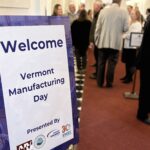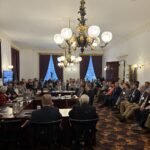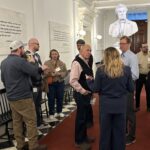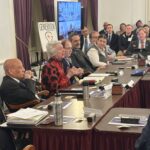Vermont Manufacturing Day Brings Business and Policy Leaders Together at the State House
Over 100 manufacturing industry leaders gathered at the State House on April 2 to engage with legislators and raise awareness of the collective contributions of this industry to the Vermont economy. Vermont Manufacturing Day, convened by the Vermont Chamber of Commerce, Associated Industries of Vermont, Regional Development Corporations of Vermont, and Vermont Manufacturing Extension Center, brought businesses together to increase awareness, build relationships, and tell the story of the industry.
The Vermont Manufacturing economy has a $3 billion annual economic impact (over 8% of the state’s GDP), supports 30,000 jobs, and represents 10.5% of Vermont’s workforce. Businesses, legislative leaders, and Administration officials collaborated for a day of advocacy to elevate the collective contributions of the manufacturing sector to Vermont. Advocacy day highlights included a joint hearing with the Senate Committee on Economic Development, Housing and General Affairs and House Committee on Commerce and Economic Development, a listening session with Speaker Jill Krowinski, a listening session with Lieutenant Governor John Rogers, and a joint resolution recognizing April 2, 2025 as Vermont Manufacturing Day.
Rep. Jonathan Cooper (Bennington-1), shared “In this resolution, we affirm the value and necessity of a thriving manufacturing sector in the Green Mountain State. Accounting for more than 10 percent of Vermont’s private sector jobs, and boasting an average wage well above the statewide figure, the manufacturing industry provides a variety of high-quality, skilled jobs that are the backbone of our state’s economy. This sector plays a key role in both economic stability and prosperity, particularly in our rural communities,” commented Rep. Cooper.
“What sets Vermont manufacturers apart is their commitment to collaboration and continuous improvement. They are agile, people-focused, and solutions-oriented. And that culture of excellence is essential to building a more competitive, more resilient Vermont economy,” said Amy Spear, President of the Vermont Chamber of Commerce. “Manufacturing Day is more than a celebration—it’s a vital opportunity to connect Vermont’s business leaders and legislators. It’s how we strengthen understanding, build partnerships, and advance policies that support a thriving manufacturing sector.”
At the press conference, Vermont Commerce Secretary Lindsay Kurrle shared, “Manufacturers produce goods, create high-quality and high-paying jobs, and contribute to the economic success of Vermont. From aerospace to semiconductors and injection molding to socks – our manufacturing landscape is varied and thriving. At the Agency of Commerce and Community Development, our Department of Economic Development team is invested in manufacturing. We are committed to recruiting new businesses to Vermont and supporting the ones that are already here.”
“Manufacturers across Vermont face challenges including high energy costs, aging infrastructure, and a tight labor market. It’s important that we all work together to develop targeted programs that provide both immediate and long-term support to overcome these challenges,” said Alex Demoly, Vice President of the Greater Burlington Industrial Corp. “With continued industry support, we can help Vermont manufacturers modernize their facilities, improve their competitiveness, and expand their workforce development efforts.”
Business leaders highlighted the following sentiments in their testimonies: the role of manufacturing in helping to sustain a diverse economy that supports a range of other industries, the sector’s centrality in providing jobs and fostering innovation throughout the state, including in more rural communities, and the collective challenges facing businesses in the industry, including: workforce development and access to skilled labor, workforce housing accessibility and affordability, and rising costs.
“According to Deloitte, the U.S. is projected to have more than 2 million unfilled manufacturing jobs by 2030 nationwide. With Vermont’s aging population and a housing crisis, we are particularly vulnerable to being even further left behind,” said Diane Abruzzini. “There is momentum towards reshoring manufacturing back to the U.S. and Vermont has a real opportunity to be a part of that. To do so, we must address the structural challenges that make doing business here difficult, while building on the collaborative strengths that make Vermont a supportive place to grow.”
Additional business and policy leaders that testified were: Mike Rainville, Founder and Owner of Maple Landmark, Jim Tringe, Director of Plant Services at Cabot, Brian Kippen, President/CEO of KAD Models & Prototypes, Inc., Elizabeth Dunn, Director of Distribution and In-House Manufacturing at USA Brands, Alberto Aguilar, President and CEO at Carris Reels, and Meg Hammond, Executive Director of Generator.








SHARE THIS ARTICLE
RECENT NEWS



